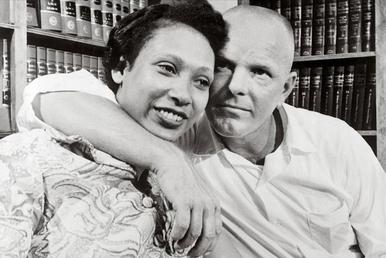
Believe it or not, as late as 1967, interracial marriage (marriage between a Black and a White) was illegal in much of the South. Interracial marriage bans were only ruled unconstitutional by the Supreme Court in the very fittingly-named case Loving v. Virginia of 1967. We will take a closer look at this case in today’s post.
In 16 states that once formed part of the Confederacy (Virginia being one of them), interracial marriage was illegal. Mildred Loving, a Black American, found out that she was pregnant to Richard Loving, a White, in 1958. In June, the couple decided to go to Washington, D.C. to get married, which was legal, to evade Virginia’s Racial Integrity Act of 1924, which made interracial marriage illegal. After returning to Virginia, though, local police raided the Lovings’ home on July 11, 1958, and the Lovings were charged with miscegenation and were both sentenced to prison for one year. However, the judge said that their sentences could be suspended as long as they left Virginia for 25 years and not come back married. Therefore, the couple moved to Washington, D.C.

In 1964, however, the Lovings grew tired of living in exile in D.C. due to financial trouble and the inability to visit family in Virginia together. After writing a letter to the Attorney General in protest, he referred her to the American Civil Liberties Union (ACLU), which agreed to file on behalf of the Lovings. The ACLU’s lawyers filed a motion to the Virginia Caroline County Circuit Court which said that interracial marriage bans were illegal under the Equal Protection Clause of the Fourteenth Amendment.
However, after not receiving a reply from the Circuit Court for over a year, the ACLU sued in the U.S. District Court for the Eastern District of Virginia. The court said interracial marriage bans were legal, and sided with the state, so ACLU appealed to the Virginia Supreme Court, which also upheld the lower court’s decision. However, the state’s supreme court did overturn the couple’s ban on returning to Virginia.
The ACLU appealed to the U.S. Supreme Court, which heard oral arguments on April 10, 1967.
The Supreme Court issued their unanimous 9-0 decision on June 12, 1967, ruling in favor of the Lovings, striking down interracial marriage bans. In the majority opinion which all justices joined, Chief Justice Earl Warren wrote that the interracial marriage ban violated both the Equal Protection Clause and the Due Process Clause of the Fourteenth Amendment. He wrote:
There can be no question but that Virginia’s miscegenation statutes rest solely upon distinctions drawn according to race. The statutes proscribe generally accepted conduct if engaged in by members of different races. … There can be no doubt that restricting the freedom to marry solely because of racial classifications violates the central meaning of the Equal Protection Clause.
Loving , 388 U.S. at 11–12.
The decision struck down all laws banning interracial marriage in all states. At long last, two people of different races could now freely marry each other anywhere in the United States.
Following the decision, interracial marriages steadily increased, from just .4% in 1960 to 2% in 1980, and 17% today. Although interracial marriage ban laws still existed in some state’s laws, they were now unenforcable. The last state to officially remove the interracial marriage ban from their Constitution was Alabama, in 2000.
The case also helped pave way for the legalization of same-sex marriage in the 2015 case of Obergefell v. Hodges, a case which we will be covering in another post.
The case has also made its way into popular culture, and was even made into a movie called Loving (2016). Mildred Loving, who died in 2008, is now honored as one of the Library of Virginia’s “Virginia Women in History.” June 12 is now also commemorated as “Loving Day.”